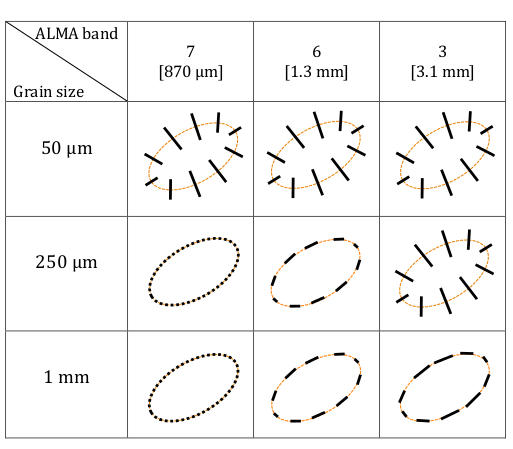Polarized emission by aligned grains in the Mie regime : application to protoplanetary disks observed by ALMA
Guillet, V.; Girart, JM., Maury, A.J.; Alves, F.
Published in A&A, JANUARY 2020The azimuthal polarization patterns observed in some protoplanetary disks by ALMA at millimeter wavelength have raised doubts about their being produced by dust grains aligned with the magnetic field lines. These conclusions were based on the calculations of dust polarized emission in the Rayleigh regime, i.e. for grain sizes much smaller than the wavelength. However, the grain size in such disks is estimated to be typically in the range 0.1 - 1 mm from independent observations. We study the dust polarization properties of aligned grains in emission in the Mie regime, i.e. when the mean grain size approches the wavelength. Using the T-MATRIX and DustEM codes, we compute the spectral dependence of the polarization fraction in emission for grains in perfect spinning alignment, for various grain size distributions of weakly-elongated oblate and prolate grains of astrosilicate composition, with a mean size ranging from 10 {\mu}m to 1 mm. In the submillimeter and millimeter wavelength range, the polarization by B-field aligned grains becomes negative for grains larger than ~ 250 {\mu}m, meaning that the polarization vector becomes parallel to the B-field. The transition from the positive to the negative polarization occurs at a wavelength {\lambda} ~ 1 mm. The regime of negative polarization does not exist for grains smaller than ~ 100 {\mu}m. When using realistic grain size distributions for disks with grains up to the submillimeter sizes, the polarization direction of thermal emission by aligned grains is shown to be parallel to the direction of the magnetic field over a significant fraction of the wavelengths typically used to observe young protoplanetary disks. This property may explain the peculiar azimuthal orientation of the polarization vectors in some of the disks observed with ALMA and attest of the conserved ability of dust polarized emission to trace the magnetic field in disks.
